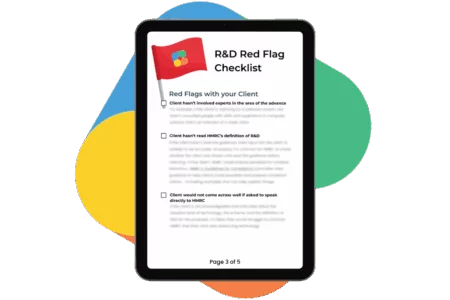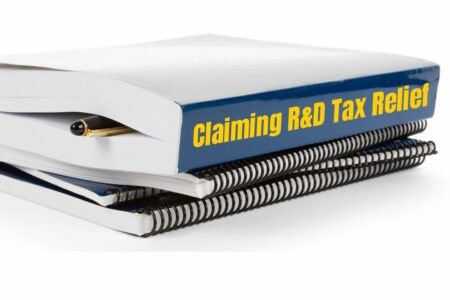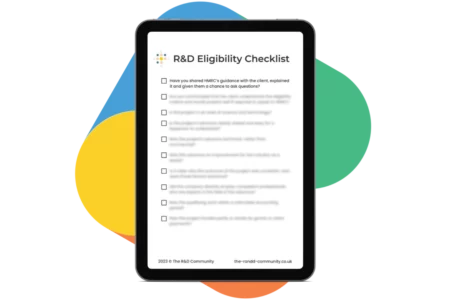Without a good quality control process in place, there’s a risk of mistakes which might lead to delays, rejections or even penalties.
Here’s why having a good quality control process is important and what to do to set one up.
What is quality control for R&D tax relief claims?
In this context, quality control means checking if the claim meets the requirements set out by HMRC and the Professional Conduct in relation to Taxation (PCRT). It also ensures all necessary information is included.
Why is quality control important for R&D Tax Relief claims?
R&D tax relief can be a complex part of a client’s overall corporate tax position. Mistakes can be costly. If HMRC identifies any errors or inconsistencies in a claim, it may lead to delays in processing or even rejection. In some cases, businesses may be subject to penalties or fines for making incorrect claims.
Having a good quality control process can help you and your clients avoid these risks. By checking and double-checking the claim before it’s submitted, businesses can ensure all necessary information is included and the claim meets HMRC’s requirements.
Implementing a quality control process for R&D tax relief claims
Implementing a quality control process for R&D tax relief claims involves a few steps. Here’s the key elements.
Pick an R&D “champion” who can identify gaps in training
Assigning a person to be responsible for overseeing the quality control process can help the process run smoothly. This person should have a good understanding of R&D tax relief rules and be able to identify potential issues with the claim. They can also monitor CPD requirements and identify training gaps. Ideally, they’re able to find resources to fill these gaps.
If you work alone, you’ll need to be your own “champion.” That means it’s vitally important you stay up to date with the latest developments in R&D tax relief. Regardless, checking and updating your overall knowledge is a good idea and will help meet CPD requirements.
We have loads of free resources dedicated to R&D tax relief here on our website. These include A Beginner’s Guide to Claiming R&D Tax Relief; a great resource for a new team member who might need to familiarise themselves with the rules. Or, if you’re looking for something more advanced to help with HMRC enquiries then check out the Insider’s Guide to R&D Tax Relief Enquiries 2023.
Document the QC process
Documenting the quality control process helps ensure all steps are followed consistently. Regularly using this document will build a “conversation framework”. It will make you and your team much more confident when talking to clients about their eligibility.
It should include checklists of items to review, red flags, timeframes for completing each step, and the roles and responsibilities of each team member involved in the process.
Our eligibility checklist provides this framework and is short and simple. It can be printed so you can take it into client meetings. If assessing eligibility is an issue, The R&D Community offers members an eligibility screening service as part of its Claims Support. This is invaluable as it avoids the difficulties that come with preparing a claim for an ineligible client.
Review the claim
Review the claim for accuracy and completeness. This includes checking if all relevant information is included. That means checking the details of each R&D project and the eligible costs incurred.
It’s always best to identify and address any “red flags” which may attract HMRC’s attention before you submit the claim. Otherwise you might end up with an enquiry which could have been avoided.
It’s also good practice to avoid using certain ‘red flag’ phrases, especially without further explanation, as these can indicate to HMRC the claim is weak. If you would like to know more about the sort of things HMRC look out for, download our R&D red flag checklist
Get a second opinion
Before finalising a claim, getting a second opinion from another qualified professional or R&D specialist can help to ensure the claim is accurate and meets the requirements set out by HMRC. If you and another expert advisor can set up a partnership to support this, that might well. If you can’t find one you trust, you do have other options!
Being a member of The R&D Community not only gives you access to training but also to our support services. If you have a question about a claim, you can use the R&D Helpline to get advice from the experts on our team. For more general insights and for a range of opinions, our community-wide WhatsApp group is a great place to ask questions of other advisors. And for a more in-depth review of the claim, we can provide that through our Claim Support service.
Submit the claim
Once the quality control process is complete, and the client has reviewed and agreed the claim, the main tax agent can submit the claim to HMRC within the appropriate time frame. Having a good working relationship with the agent who is responsible for filing the claim is imperative and discussing and sharing your QC process with them should help to build this relationship.
Next steps
Having a good quality control process is essential if you want to ensure your claims meet the requirements set out by HMRC and the PCRT. By implementing a thorough process, costly mistakes can be avoided and your reputation protected.
The R&D Community exists because we know preparing a claim is complex and can feel overwhelming. Like with anything detailed and important, it’s best to take it one step at a time and learn as much as you can about the subject. You can get started with your own quality control process by using these free resources.
If you have questions about membership, or how we can take part in your QC process, feel free to get in touch. We’d love to help!





